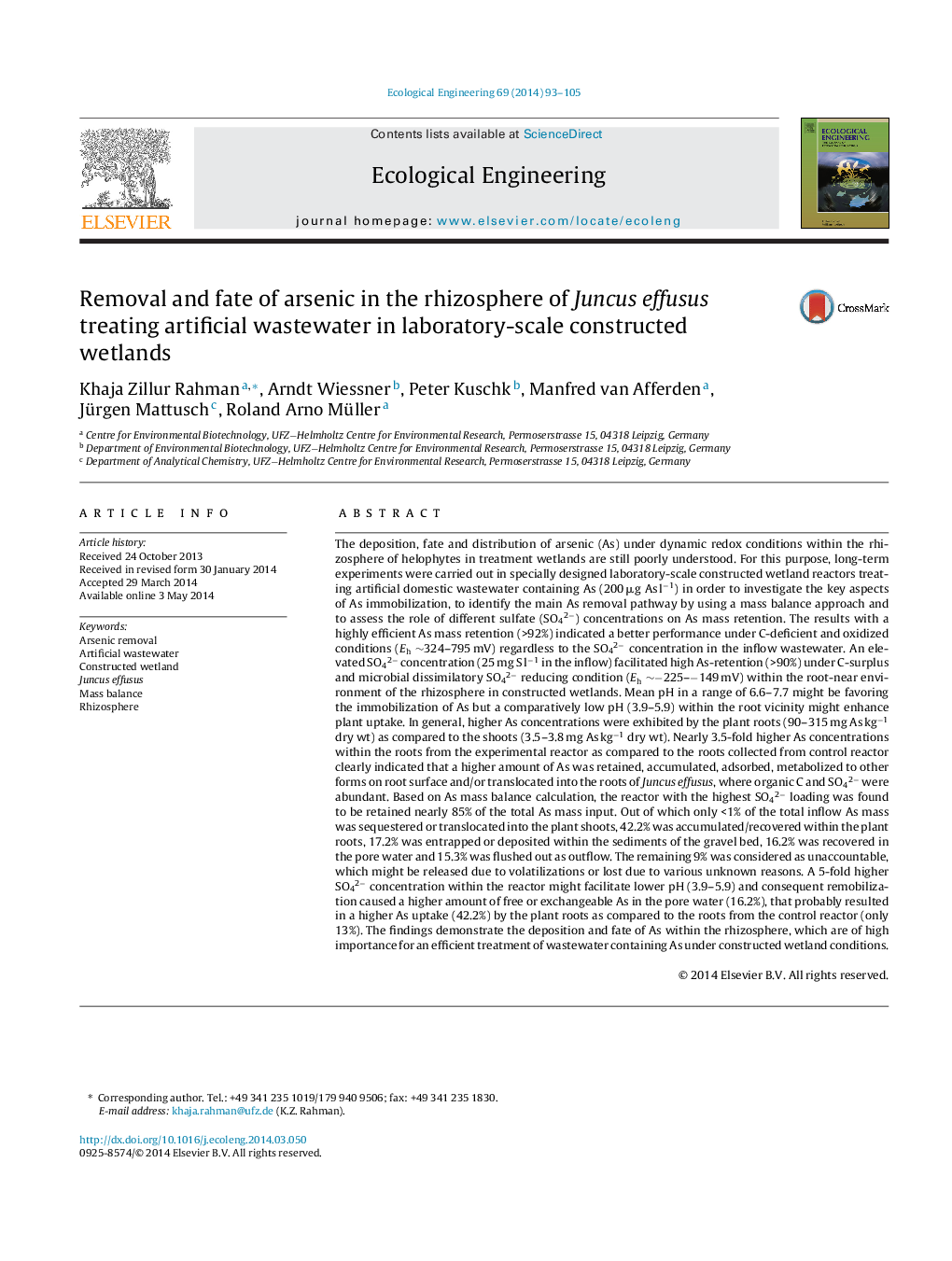| Article ID | Journal | Published Year | Pages | File Type |
|---|---|---|---|---|
| 4389379 | Ecological Engineering | 2014 | 13 Pages |
•We investigate the key aspects of As removal pathway in constructed wetlands.•Redox, pH and elevated sulphate concentration play important roles on As removal.•A decrease of pH may enhance plant As uptake via root biomass.•Juncus effusus possess a very high As concentration within the roots than shoots.•Roots and sludge sediments are primary sinks for As retention in the rhizosphere.
The deposition, fate and distribution of arsenic (As) under dynamic redox conditions within the rhizosphere of helophytes in treatment wetlands are still poorly understood. For this purpose, long-term experiments were carried out in specially designed laboratory-scale constructed wetland reactors treating artificial domestic wastewater containing As (200 μg As l−1) in order to investigate the key aspects of As immobilization, to identify the main As removal pathway by using a mass balance approach and to assess the role of different sulfate (SO42−) concentrations on As mass retention. The results with a highly efficient As mass retention (>92%) indicated a better performance under C-deficient and oxidized conditions (Eh ∼324–795 mV) regardless to the SO42− concentration in the inflow wastewater. An elevated SO42− concentration (25 mg S l−1 in the inflow) facilitated high As-retention (>90%) under C-surplus and microbial dissimilatory SO42− reducing condition (Eh ∼−225–−149 mV) within the root-near environment of the rhizosphere in constructed wetlands. Mean pH in a range of 6.6–7.7 might be favoring the immobilization of As but a comparatively low pH (3.9–5.9) within the root vicinity might enhance plant uptake. In general, higher As concentrations were exhibited by the plant roots (90–315 mg As kg−1 dry wt) as compared to the shoots (3.5–3.8 mg As kg−1 dry wt). Nearly 3.5-fold higher As concentrations within the roots from the experimental reactor as compared to the roots collected from control reactor clearly indicated that a higher amount of As was retained, accumulated, adsorbed, metabolized to other forms on root surface and/or translocated into the roots of Juncus effusus, where organic C and SO42− were abundant. Based on As mass balance calculation, the reactor with the highest SO42− loading was found to be retained nearly 85% of the total As mass input. Out of which only <1% of the total inflow As mass was sequestered or translocated into the plant shoots, 42.2% was accumulated/recovered within the plant roots, 17.2% was entrapped or deposited within the sediments of the gravel bed, 16.2% was recovered in the pore water and 15.3% was flushed out as outflow. The remaining 9% was considered as unaccountable, which might be released due to volatilizations or lost due to various unknown reasons. A 5-fold higher SO42− concentration within the reactor might facilitate lower pH (3.9–5.9) and consequent remobilization caused a higher amount of free or exchangeable As in the pore water (16.2%), that probably resulted in a higher As uptake (42.2%) by the plant roots as compared to the roots from the control reactor (only 13%). The findings demonstrate the deposition and fate of As within the rhizosphere, which are of high importance for an efficient treatment of wastewater containing As under constructed wetland conditions.
Graphical abstractFigure optionsDownload full-size imageDownload as PowerPoint slide
